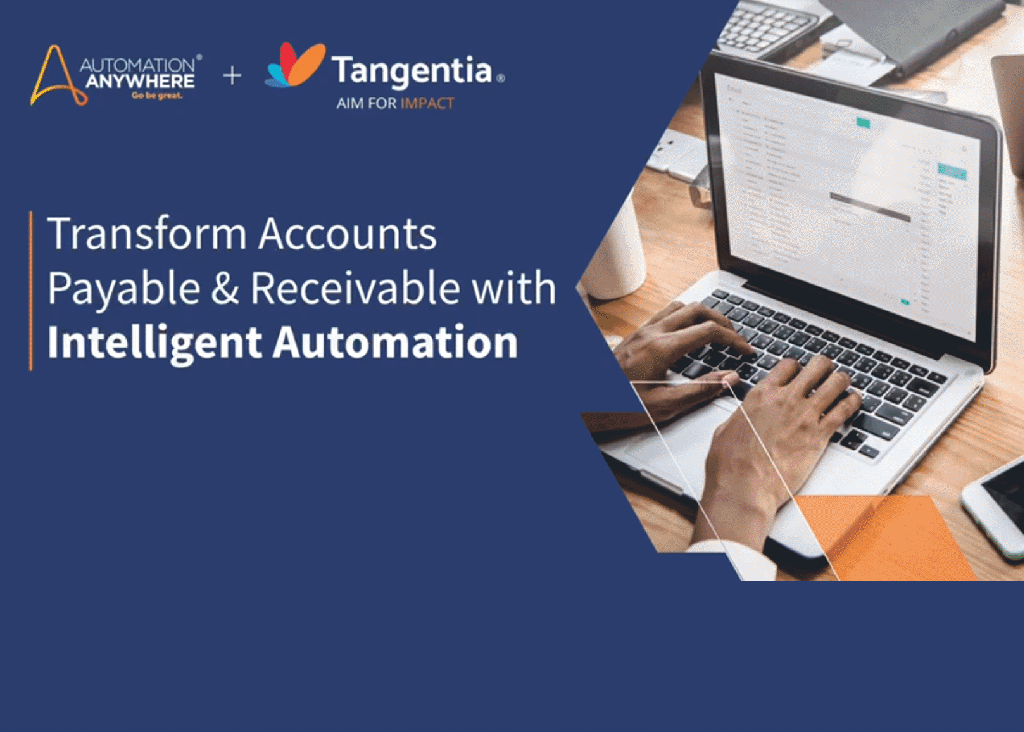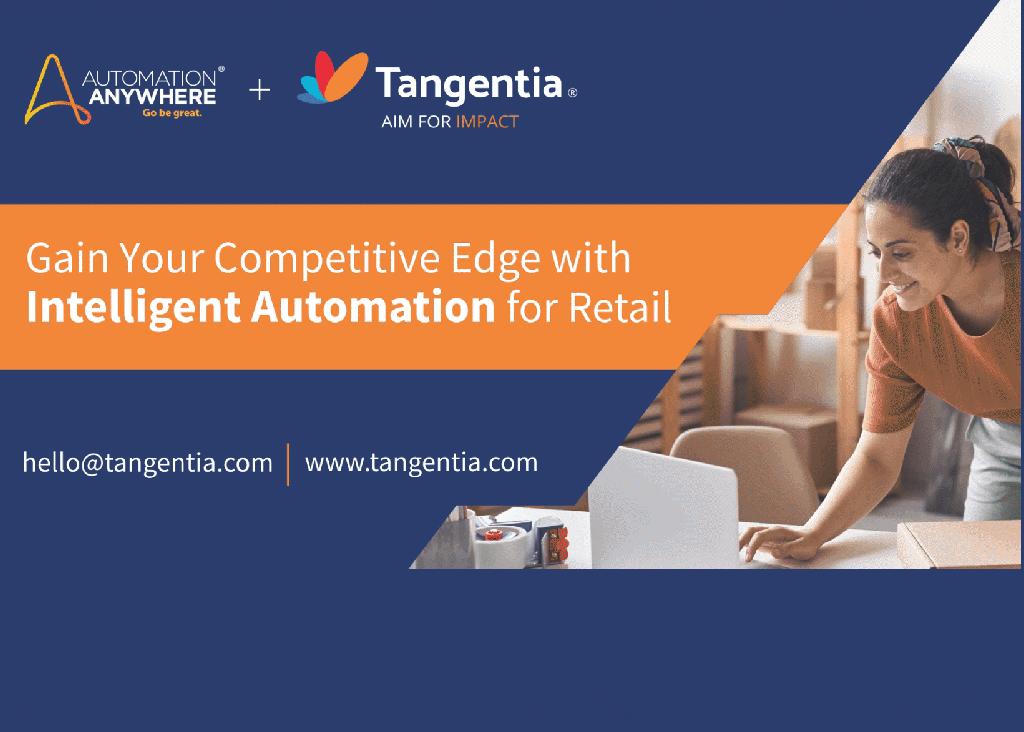Month: June 2021
Monthly Tangentia Byte June 2021
|
|
||||||||||||||||||||||||||||||||||||||||||||||||||||||||||||
|
||||||||||||||||||||||||||||||||||||||||||||||||||||||||||||
Case Study : Summit Wealth & RPA
Ebook – Robotic Process Automation in 2021: Where We See RPA Going
How to Build a Business Case for RPA
Robotic Process Automation (RPA) is arguably one of the most transformative technologies in the business world. It can be used to streamline a business across the board, from network security to payroll and order fulfillment. For anyone who’s been paying attention, the benefits are as clear as day.
You already know this, of course. That’s why you’re here. You don’t need us to convince you about the value of RPA — you need to convince the decision-makers in your business.
Fortunately, that won’t be difficult to do. As you’ll soon see, the numbers speak for themselves. First thing’s first, however, you’re going to need a plan.
It All Starts With Your Roadmap
In order to properly conceptualize and explain the specific ways that RPA can benefit your business, it’s imperative that you first know exactly how it will be used within your organization.
For instance, will you apply it to your reporting, eliminating hours of data entry? Will you use it to process invoices for your customers, enabling faster fulfillment times and eliminating potential invoicing errors? Or will you use RPA to streamline your onboarding process so that new employees can get to work that much faster?
The possibilities are, as they say, limitless.
You likely started exploring RPA with a specific problem or set of processes in mind. That’s good. Zero in on that for now, and answer the following questions:
- What specific challenge or problem am I looking to address with RPA? This is your starting point. Your mission statement.
- Who will use the deployment? Will RPA be leveraged by multiple departments, or is it exclusively for one segment of the organization?
- What is the projected timeframe of this deployment? You’ll want concrete dates planned out for your proof of concept/pilot deployment and each phase thereafter.
- How will this project be integrated? What software needs to be tied to the bots once they’re deployed? Are there any potential implementation challenges?
- What governance models will we use? Depending on your project’s level of complexity, you’ll want to chart out one or even several RPA governance models, each of which hits the following beats:
- Clearly established roles and responsibilities, including leadership, support, administrative, etc.
- An accountability framework to help ensure everyone stays on task.
- An approvals process for proposing and deploying new RPA bots.
- Security & compliance standards, processes, and protocols.
- Best practices for managing and configuring software and (if relevant) hardware architecture.
- Best practices for cost management.
- A framework for the timely development and deployment of each bot.
- A process for change management — RPA is a highly dynamic technology, and your needs are likely to shift or scale over time.
- What tangible examples currently exist for my projected use case? You’ll want to find as many concrete examples as possible. Not only will this allow you to make a stronger case for deployment — demonstrating that yes, this does work — it will also allow you to extrapolate your potential return on investment. To find these examples, you can look in a few places.
- Case studies published by RPA service providers. The more similarities between your business and the client organization, the better.
- Press releases detailing RPA deployments.
- Statistics and research briefs released by analysts (ie. Gartner).
- What is the total cost of ownership associated with this project? Structure the breakdown of costs so that it aligns with your proposed deployment schedule.
- What is the end goal of this deployment? For example, increasing productivity by 10% or reducing order fulfillment times by 20%. Make sure you set realistic expectations here, lest your project loses the approval of the higher-ups.
Costs, Benefits, and Potential
Armed with the research you did in the previous step, it’s time to crunch some numbers. First, you want to do a cost-benefit analysis of your project. You want to be as comprehensive as possible here, quantifying every single potential expense and gain.
You’ll also want to calculate your return on investment. What, at the end of the day, does your business ultimately gain from this deployment? What tangible value will this project generate for the business?
Finally, take a brief moment to brainstorm what other areas of your organization might benefit from RPA. In a pinch, having this information on hand could help seal the deal and bring someone who’s still on the fence over to your side. Don’t just focus on broad departments, drill down to specific processes.
Your CBA and ROI are the two figures that really matter here.
The Pitch
Now that you’ve done your research and crunched some numbers, it’s time to think about how you’re going to make your case. Start with the challenge; your reason for proposing the deployment.
Focus on what the issue is costing your business — on what you lose if you leave the problem unaddressed. Again, concrete numbers are your friend here. You want to provide them with specifics.
How many hours of productivity do they lose? How much money is this problem costing them? How many more clients could they serve if they deployed RPA?
From there, you’ll want to explain in layman’s terms precisely how a well-executed RPA strategy can address this problem. Don’t bother going into detail about the features or functions of RPA. Focus on the results.
With any luck, you’ll have made a strong enough case to move forward with your deployment.
Closing Thoughts
So, in summary, to make your case in favor of RPA, you need:
- A strong foundation. What specific outcomes do you desire from this project?
- A comprehensive roadmap, which includes integration plans and target deployment dates.
- Strong evidence in favor of RPA’s beneficial impact in your industry.
- A full analysis of how RPA can benefit your business, detailing which specific processes it might be applied to.
- CBA and ROI data.
- A well-articulated pitch script.
We won’t lie and say it will be easy. But the end result is worth it. And if, after reading this piece, you still aren’t sure where to start or where to go, Tangentia can help.
We have nearly two decades of experience in the automation space and have worked with multiple customers and systems worldwide. We’re also partnered with multiple RPA vendors, meaning that no matter your use case or business model, we have the expertise and the connections you need.
Book a discovery call today, and we’ll help you make your case.
UiPath vs. Automation Anywhere: Which is the Best RPA Solution for You?
Where Robotic Process Automation is concerned, UiPath and Automation Anywhere are arguably the two reigning titans. Each one has its own unique approach to the industry, and each one is suited for a specific type of use case — and as specific set of industries.
Download Ebook
Get Started on Your RPA Journey Today
Talk to an RPA Expert to learn how to get started
Infographic : The Key to Digital Transformation for Manufacturing
RPA in Manufacturing – Automate Your Processes, Improve Your Value Chain and Thrive
When we think of the use of robotics in manufacturing, physical robots performing repetitive tasks on the factory floor, such as assembling and packaging products, are often the first thing that comes to mind. However, the use of robots in manufacturing is taking a new turn with robotic process automation (RPA). RPA is the use of software robots—or bots—that perform repetitive manual tasks related to back-office and front-office processes in much the same way physical robots perform manual physical tasks.
The use of RPA in manufacturing is about taking operational efficiency to the next level. This includes the operational efficiency of workflows that provide the most value for an organization and its customers, suppliers, and other partners. According to MAPI, 84% of manufacturers are either using, implementing, or planning to implement RPA in order to streamline their operations in finance, information systems, business strategy, and risk and compliance. The result is an improved value chain between the supplier and the customer.
Improving the Value Chain
The value chain between the supplier and the customer is a series of critical processes that include logistics, procurement, accounts receivables and payables, supply and demand planning, order management, inventory management, customer service, and regulatory compliance. The benefits of RPA in these areas are many, including such things as:
- The automation of data acquisition from multiple sources and the filling out of forms
- Improved data management and real-time data analytics
- Results that are consistent and free of error
- Increased accuracy in estimating delivery times
- Full regulatory compliance even as regulations change
- A full trail of documentation for work that is performed
With this in mind, here are a few use cases for what can be automated using RPA in manufacturing.
Logistics
RPA makes it possible to automate the entire logistics process, assessing various carriers and insurance options to determine the optimal balance between transport time and cost. In addition, RPA allows you to monitor the transportation of raw materials and finished goods with real-time freight tracking and reporting.
Demand Planning
RPA has the ability to draw data from a variety of data sources, making it possible to gather enough information to accurately determine demand. This information, which includes data such as market trends, internal sales forecast, competitive analysis, and product catalog information, can be imported, processed, and cross-referenced to determine an accurate sales forecast.
Bill of Materials
The Bill of Materials (BOM) is a critical document when it comes to the manufacture of new products. it can take a lot of time for a human worker to go through the BOM and gather the required information to determine what to purchase and where to make those purchases. RPA can pull the required information from the BOM in a fraction of the time with increased accuracy. This will drive the creation of new products, ensuring they are completed on time every time.
Onboarding New Suppliers
The BOM requires the use of the right suppliers across all categories. Assessing potential suppliers requires a lot of information gathering from many disparate documents. RPA makes it possible to automate the collection of this information. The bots can analyze proposals, gather supplier information and consolidate this data into a ready reckoner and evaluation sheet that can be of help during negotiations.
Navigating the COVID Crisis and Beyond
All the benefits RPA brings to the value chain in manufacturing is helping manufacturers not only weather the COVID pandemic but come out of it stronger than ever before. The COVID pandemic has resulted in lower supplier production and a decrease in inventory, while at the same time, the cost of logistics and transportation is higher than ever.
The ability of RPA to streamline inventory management, navigate supply and demand planning, manage inbound logistics and automate the supplier onboarding process makes it possible for manufacturers to scale and adapt to the changing requirements of the industry.
For more information on how RPA can help your manufacturing company, reach out to our sales team today.































